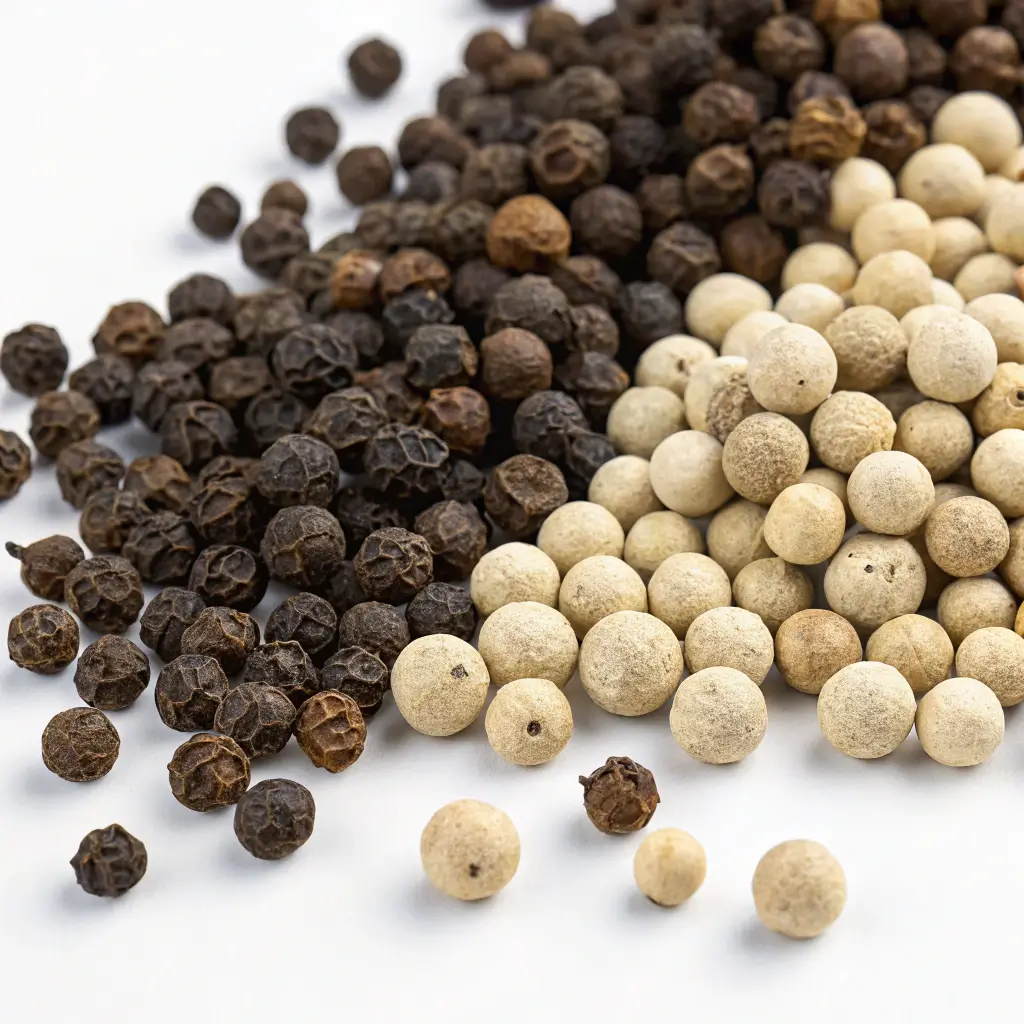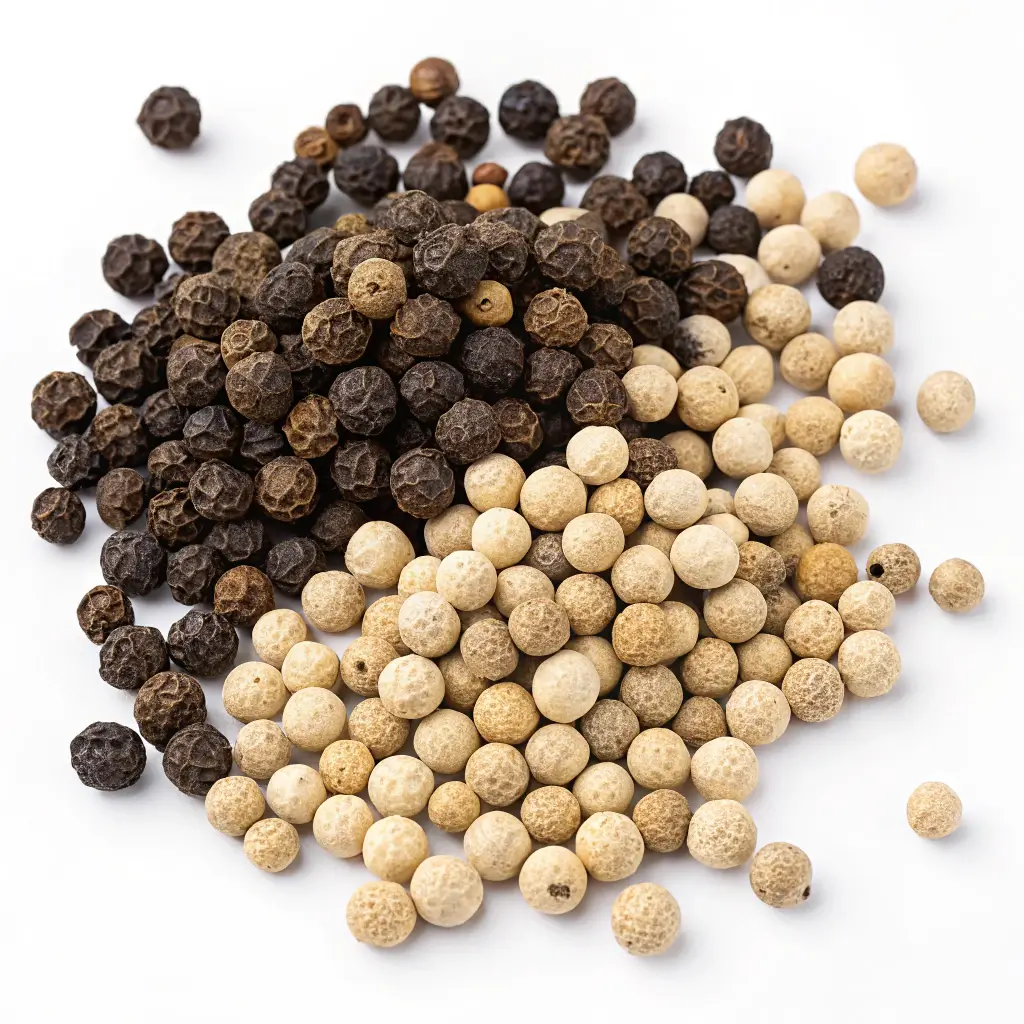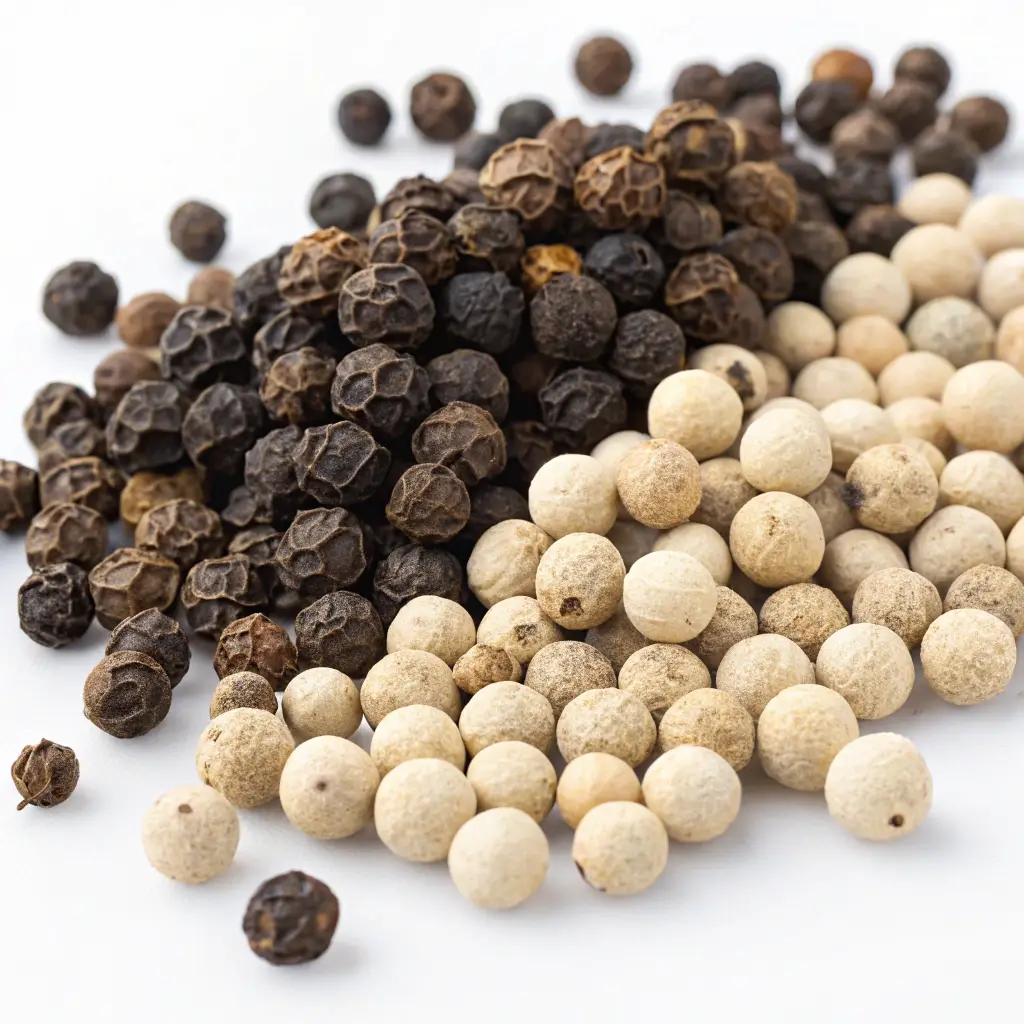When it comes to seasoning, few spices are as essential as pepper. But not all pepper is the same. White peppercorns vs black peppercorns might seem like a subtle difference at first glance, yet they offer distinct flavors, health benefits, and culinary uses. Interestingly, they come from the same plant “Piper nigrum” but are processed differently to create two very different seasonings.
In this article, we’ll explore the real differences between white and black peppercorns so you can choose the right one for your health, flavor preferences, and cooking needs.
Table of Contents
What Are White and Black Peppercorns?
Both black and white peppercorns come from the berries of the Piper nigrum vine, a flowering plant native to South India.
| Feature | Black Peppercorns | White Peppercorns |
|---|---|---|
| Harvest Time | Unripe green berries | Fully ripe berries |
| Processing | Sun-dried with outer skin intact | Soaked, fermented, and outer skin removed |
| Final Form | Wrinkled, black outer skin | Smooth, pale inner seed |
| Shelf Stability | Longer (outer skin protects inner oils) | Slightly shorter (no skin protection) |
This difference in processing creates dramatic changes in flavor, appearance, and health-promoting properties, which we’ll now explore.
Flavor Profile in White Peppercorns vs Black Peppercorns
| Taste Element | Black Peppercorns | White Peppercorns |
| Heat Level | Bold, slow-building heat | Quick, sharp heat that fades faster |
| Aroma | Strong, citrusy, earthy | Mild, slightly fermented or musty |
| Culinary Use | Versatile in all savory dishes | Best for light dishes, soups, and Asian recipes |
Black peppercorns work best in hearty dishes where their strong aroma can shine. In contrast, white peppercorns are ideal for dishes where you want heat without visible flecks or overpowering scent.

Appearance & Culinary Considerations
When choosing between white peppercorns vs black peppercorns, appearance can be a deciding factor:
- Black peppercorns add dark specks to sauces and dressings, which might be unwanted in certain presentations.
- White peppercorns blend seamlessly into cream-based soups and light sauces.
Also, black pepper’s skin contains more volatile oils, enhancing not only taste but also its therapeutic properties.
Pro Tip: If you’re making béchamel sauce, mashed potatoes, or egg dishes, opt for white peppercorns to maintain a smooth, clean appearance.
Health Benefits Compared: White Peppercorns vs Black Peppercorns
Both varieties contain piperine, but their health benefits differ due to how they are processed.
Shared Health Benefits:
- Boost nutrient absorption (especially with turmeric and selenium)
- Support digestion and enzyme production
- Offer antioxidant support
Unique to Black Peppercorns:
- Higher piperine concentration (retains outer skin)
- May offer stronger cognitive and anti-inflammatory benefits
Unique to White Peppercorns:
- Gentler on sensitive stomachs
- Used in traditional Eastern remedies for bloating
In terms of health impact, black peppercorns provide a more intense nutritional punch, while white peppercorns are a gentler alternative with targeted uses.
White Peppercorns vs Black Peppercorns: How They’re Made
| Processing Step | Black Peppercorns | White Peppercorns |
| Harvest | Unripe green | Fully ripe |
| Preparation | Sun-dried | Soaked in water for several days |
| Outer Skin Treatment | Retained | Removed after fermentation or rubbing |
| Final Color | Black | Ivory or pale beige |
The removal of the outer skin in white pepper changes not only the flavor and texture but also lowers the concentration of certain essential oils and nutrients.

Which Is More Expensive?
Cost Differences in White Peppercorns vs Black Peppercorns
White peppercorns typically cost more due to:
- Extra labor for soaking and skin removal
- Fermentation and drying time
- Smaller yield after processing
That said, they are often used sparingly and in specific dishes where their visual and flavor subtleties matter most.
Grinder & Storage Tips
To get the best flavor and health benefits from white peppercorns vs black peppercorns, proper grinding and storage are essential:
- Use separate grinders to avoid cross-contamination of aroma.
- Opt for ceramic grinders, especially for white peppercorns, which may react with metal.
- Store in airtight, dark containers away from heat and moisture to preserve oils.
Grinding fresh peppercorns right before use ensures maximum potency in both flavor and health-supporting compounds.
White Peppercorns vs Black Peppercorns in the Kitchen
If you’re out of one, here are suitable culinary swaps:
| Need | Try This Substitute |
| No black peppercorns | White pepper, allspice, or green pepper |
| No white peppercorns | Black pepper (for dark dishes), ginger, or Sichuan pepper |
Keep in mind:
- Substitutes won’t perfectly mimic the original.
- Some substitutes add sweetness or floral notes that may change the dish’s balance.
Which One Should You Use? A Practical Breakdown
| Scenario | Best Choice |
| Cooking with dark sauces or meats | Black peppercorns |
| Preparing light sauces or creamy dishes | White peppercorns |
| Seeking bold aroma and antioxidants | Black peppercorns |
| Sensitive digestion or visual concerns | White peppercorns |
Having both in your spice rack allows you to choose based on function, flavor, and presentation.
Conclusion
The debate between white peppercorns vs black peppercorns isn’t about which is better, it’s about what’s right for your needs. Each brings its own unique flavor, appearance, and nutritional profile to the table.
Use black peppercorns when you want robust heat, stronger antioxidants, and aromatic richness. Choose white peppercorns for delicate dishes, digestive ease, and visual simplicity.
By understanding their differences, you’re not just cooking, you’re elevating your meals with purpose. Want to learn more? Explore our spice guide series or leave a comment with your favorite way to use pepper! and make sure you Follow on Facebook.
FAQ about White Peppercorns vs Black Peppercorns
Can I substitute white peppercorns for black peppercorns?
Yes, you can substitute white peppercorns for black peppercorns, especially in a pinch. However, expect a difference in flavor and appearance. White pepper has a milder, slightly fermented taste and is best for light-colored dishes. It lacks the bold, aromatic punch that black pepper delivers. For most recipes, the substitution works, but it may slightly change the dish’s profile.
Why do chefs prefer white pepper?
Chefs often prefer white pepper in recipes where visual presentation matters, such as creamy sauces, mashed potatoes, and soups. White pepper blends in without leaving dark specks. It’s also favored in Asian cuisines where its subtle, penetrating heat pairs well with delicate flavors. That said, chefs still rely heavily on black pepper for its aroma and complexity in robust dishes.
Do white peppercorns taste different?
Yes, white peppercorns taste noticeably different from black peppercorns. The flavor is less complex, with a quick, sharp heat and a slightly musty or fermented note due to the soaking and skin-removal process. It lacks the strong smell and lasting warmth of black pepper. This makes it better for mild or smooth flavors.
Why do Chinese use white pepper instead of black pepper? “
In Chinese cuisine, white pepper is widely preferred because of its clean taste and visual neutrality. It complements clear soups, congee, and stir-fries without overpowering the dish. White pepper also aligns with traditional medicine practices in some regions, where it’s believed to aid digestion and boost internal warmth without overstimulating the body.




